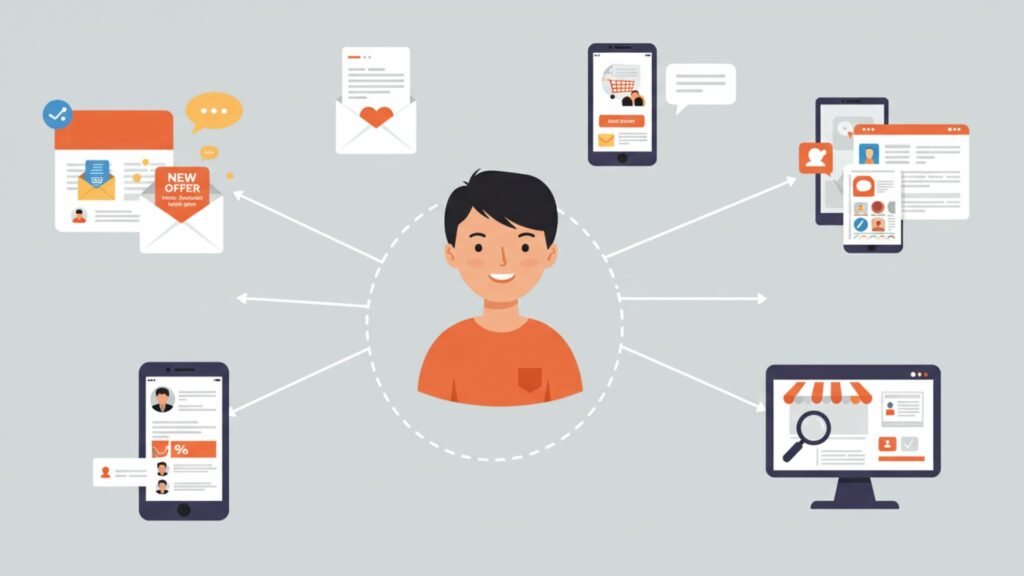Consumers are bombarded with more content than ever, yet they expect every interaction to feel uniquely tailored to them. Reports continue to find that 71% of consumers expect personalized interactions, and 76% get frustrated when they don’t receive them. This expectation isn’t limited to B2C brands either. Across industries, personalization has become a core requirement for digital marketing strategies aiming to cut through noise and drive meaningful engagement.
So, why is personalization important in digital marketing? Because it’s no longer a “nice to have” but a competitive necessity. Brands that implement personalization to boost clicks or impressions are missing the point. Effective personalization creates relevance at scale, shortens the path to conversion, and cultivates long-term brand loyalty. And thanks to advancements in AI, automation, and intelligent content operations, brands can now deliver highly targeted experiences in real time, no matter how complex their ecosystem or how fast the market evolves.
Changing Dynamics: Why is Personalization Important in Digital Marketing Today?
Personalization has shifted from a competitive edge to a foundational expectation. As digital channels multiply and customer journeys grow increasingly complex, delivering generic content simply doesn’t perform. Buyers expect brands to anticipate their needs and deliver relevant, timely content that speaks directly to their interests, whether they’re browsing a website, opening an email, or scrolling through social media.
Marketers who prioritize personalization are creating opportunities to drive higher ROI, build stronger brand trust, and reduce friction across the customer journey. Thanks to AI and data-driven decision-making, personalization now extends far beyond “first name” tokens to dynamic, behavioral-based content delivery that performs better and scales efficiently.
Rising Expectations: What Modern Consumers Demand
The need for personalization has never been more demanding. A recent Salesforce survey found that 73% of customers want companies to understand their unique needs and expectations. This demand spans demographics and industries. B2B buyers want content tailored to their role and stage in the buying cycle, while consumers want brands to anticipate their preferences and adapt in real time.
The takeaway? Static segmentation and broad personas are no longer enough. Audiences expect relevancy at every touchpoint. Meeting this demand requires digital marketing teams to integrate behavioral insights, real-time data, and modular content strategies that dynamically adapt across channels.
The Personalization-Performance Link: What the Data Shows
The bottom line is that personalized content performs better. Companies using advanced personalization strategies see up to a 20% increase in conversion rates and significant revenue gains, according to recent benchmark data. Personalized experiences increase time on site, reduce bounce rates, and lead to deeper content engagement.
What makes these results possible is the shift from manual targeting to automated personalization engines that optimize delivery based on behavior, segment, and channel. When done right, personalization improves both the customer experience and internal marketing efficiency by reducing rework and boosting asset reuse.

Beyond Names in Emails: Real-Time, Context-Aware Content Delivery
Personalization has evolved from basic tokens and triggered messages to real-time content decision-making based on who the user is, what they’re doing, and where they are in the journey. The best personalization strategies leverage AI to deliver modular content variants that respond to user behavior instantly, whether that’s adjusting homepage content, swapping product visuals, or highlighting different value props in emails.
Context-aware personalization creates a better experience and increases the likelihood of conversion. It removes irrelevant friction, delivers the right content at the right time, and builds a sense of trust that users are understood. This level of personalization is now achievable at scale with the right tools and infrastructure.
The Business Impact of Personalization at Scale
For modern marketers, the ability to personalize content at scale is a revenue driver. Businesses that invest in advanced personalization consistently outperform their peers, not just in customer satisfaction but also in bottom-line metrics like conversions, retention, and return on effort. Scalable personalization helps marketing teams maximize asset reuse, minimize waste, and optimize every touchpoint for performance.
The difference comes down to operational readiness. When digital teams have the infrastructure to automatically deliver dynamic, relevant content across channels and segments, the payoff is measurable. And that impact extends across the entire customer lifecycle, from acquisition to loyalty.
Higher Engagement, Conversions, and Customer Lifetime Value
Personalized content captures and holds attention. Whether it’s a customized product recommendation, an AI-selected homepage hero, or a tailored email flow, relevant content leads to higher engagement. Studies show that behavior-based personalization can increase conversion rates by up to 20% while enhancing customer satisfaction and loyalty over time.
This improvement translates directly into business results. Engaged users are more likely to return, spend more, and advocate for your brand. Over time, this compounds into increased customer lifetime value, turning personalization into a growth engine rather than just a tactical enhancement.
Personalized Experiences Reduce Content Waste and Rework
Without a personalization strategy, content often goes unused or underperforms because it doesn’t reach the right audience. That leads to duplicated efforts, longer cycle times, and higher content costs. With modular content models and intelligent automation, teams can deploy the right content variants where they matter most, reducing waste and extending the lifespan of high-performing assets.
Personalization also streamlines content reuse by using AI to automatically adapt or transform assets based on the target audience, channel, or region. The result is fewer redundant requests, shorter review cycles, and more time spent creating content instead of chasing edits.
Real-Time Adaptation: Meeting Customers Where They Are
Digital experiences must adapt in real time to user behavior, preferences, and context. That means updating not just what content is shown but how and when it’s delivered. Personalization engines powered by real-time data can instantly adjust messaging, visuals, and offers based on everything from past actions to current session patterns.
Agility improves the user experience and ensures that marketing dollars are working harder. When content adapts to meet a customer’s needs in the moment, it removes barriers to conversion, boosts campaign efficiency, and builds deeper brand affinity without adding manual workload to your team.
Omnichannel Personalization is No Longer Optional
Modern consumers move fluidly from web to mobile to email to social, often within a single decision-making journey. Marketing teams can no longer rely on siloed strategies or static campaigns. Omnichannel personalization ensures that each interaction builds on the last, delivering a consistent, contextually relevant experience no matter where or how the customer engages.
This shift has significant implications for how content is created, deployed, and measured. Organizations that treat omnichannel personalization as a foundational capability are better positioned to meet expectations, optimize performance, and increase marketing agility across touchpoints.

Why Fragmented Experiences Fail
When channels operate in isolation, customers feel the disconnect. They might receive an email offering a promotion on a product they already purchased or see irrelevant ads after browsing a different category entirely. These disjointed experiences erode trust and make it harder for audiences to engage meaningfully with a brand.
Fragmentation also creates internal inefficiencies, such as duplicated content, inconsistent messaging, and difficulty tracking performance across platforms. Omnichannel personalization helps eliminate these issues by unifying content operations and aligning messaging across every touchpoint, ensuring that customers encounter cohesive, timely, and relevant experiences.
Delivering Consistency Across Web, Email, Social, and Mobile
True omnichannel personalization means your audience gets the right message, in the right format, at the right moment, whether they’re opening an email, scrolling through Instagram, or shopping via a mobile app. Brands require a system capable of dynamically adapting assets based on channel-specific requirements and user context.
With the right tools in place, marketing teams can create once and deliver everywhere. Content variants, smart tagging, and AI-generated transformations ensure assets are channel-optimized while maintaining message consistency and brand integrity.
Personalization in a Cookie-Less World
The impending loss of third-party cookies has made many marketers rethink their approach to personalization. Instead of relying on anonymous tracking, successful teams are shifting toward first-party data and behavioral signals captured in real time. This opens the door for more ethical, transparent, and accurate personalization strategies.
By focusing on known behaviors, like click paths, content engagement, and past purchases, teams can serve relevant experiences without compromising user privacy. Platforms that support real-time decision-making, modular content delivery, and anonymous personalization help brands stay compliant while continuing to meet audience expectations at every stage of the journey.
Intelligent Content Operations: Powering Personalization with AI
Scaling personalization across channels, audiences, and moments is an operational challenge. Without intelligent infrastructure, even the most compelling content can fall flat due to bottlenecks, duplication, or manual effort. Intelligent content operations combine AI, automation, and modular systems to deliver personalized experiences with speed and precision.
These capabilities aren’t reserved for enterprise giants either. From mid-market teams to global brands, any organization can benefit from AI-powered content engines that eliminate guesswork, reduce waste, and turn every asset into a dynamic tool for engagement. The key is shifting from reactive workflows to proactive, data-informed decision-making at every step of the content lifecycle.
How Metadata, Smart Tagging, and Asset Variation Fuel Relevance
Personalization starts with metadata. Rich, consistent tagging enables content to be discovered, filtered, and deployed based on the needs of individual segments. But manually maintaining this metadata isn’t scalable, especially when working with thousands of assets. That’s where AI-driven tagging and smart taxonomy detection come in.
By automatically applying tags, recognizing visual or contextual themes, and mapping assets to persona-based frameworks, teams can ensure the right content is always ready for personalization. Add in asset variation tools, such as smart cropping, image swapping, or language variants, and suddenly, one piece of content can power dozens of personalized experiences.
Using Content Intelligence to Identify Gaps and Opportunities
Personalization only works if you have the right content to support it. Content intelligence uses behavioral data, engagement trends, and conversion insights to pinpoint what’s working, what’s missing, and where improvements will have the most impact. It closes the loop between strategy and execution, ensuring your personalization efforts are backed by evidence, not guesswork.
For example, if a specific user segment is consistently bouncing from a product page, content intelligence might recommend a new variant, an asset refresh, or a more targeted call to action. These recommendations enable marketing teams to fill personalization gaps quickly and strategically, improving ROI and campaign agility.
Automating Personalization Without Losing Brand Control
One of the biggest misconceptions about personalization at scale is that it leads to chaos or off-brand messaging. In reality, intelligent workflows and automation actually enhance brand control. By setting predefined rules, compliance checkpoints, and AI-driven content reviews, teams can deliver dynamic experiences while maintaining consistency and governance.
From automated asset approval flows to content detection tools that flag risk or off-brand elements, intelligent operations act as both accelerators and safeguards. The result is a personalization system that’s fast, flexible, secure, and capable of meeting the moment without introducing compliance or brand safety concerns.
Getting Started with Scalable Personalization
Many teams recognize the value of personalization but struggle with where to begin. You don’t need a massive transformation to start seeing results. Scalable personalization begins with foundational steps: organizing content, aligning data, and enabling workflows that support speed and agility.
The path to personalization starts with operational readiness. With the right infrastructure in place, personalization is about continuous, data-driven improvement.
Start with Data: Behavior, Segments, and Preferences
Every effective personalization strategy is rooted in data. This includes both explicit data (like form fills or preferences) and implicit data (such as click patterns, time on page, or purchase history). Start by mapping your customer journeys and identifying where behavior can guide decision-making, then use that to inform what content is shown and when.
Implementation doesn’t require complex customer data platforms out of the gate. Even small teams can begin leveraging real-time engagement signals to adjust content delivery. The goal is to use what you know, however limited, to make the experience more relevant and reduce friction at key conversion points.
Modular Content Models for Maximum Reuse
Scaling personalization without scaling production effort starts with modular content. Instead of building one-off assets for each audience or channel, modular models break content into reusable blocks (headlines, images, CTAs, product highlights) that can be dynamically assembled based on user context.
You can accelerate time to market while reducing duplication and improving governance. A modular approach also makes A/B testing and optimization far more efficient. When paired with AI tools that auto-tag, transform, or localize content, modularity becomes a force multiplier for delivering personalized experiences at scale.

Cross-Functional Workflows to Support Speed and Quality
Content personalization touches many teams, from creative and digital to compliance and analytics. To scale effectively, workflows must be designed to support collaboration across functions without introducing delays or rework. That means integrating review processes, automating handoffs, and giving stakeholders visibility into status and performance.
A centralized content operations platform streamlines intake, tracks feedback, and enables asset deployment without context switching. When workflows are intelligent, intuitive, and interconnected, teams can move faster while maintaining brand integrity and creative quality.
Build Experiences, Not Just Content
Why is personalization important in digital marketing? When delivered intelligently and at scale, personalization improves relevance, deepens engagement, and drives real business outcomes. From higher conversion rates to more efficient content operations, the benefits ripple across teams and touchpoints.
At Aprimo, we help marketing and digital teams do exactly that. Our platform combines AI-powered content operations, smart digital asset management, and modular content tools to make personalization scalable, efficient, and on-brand. Whether you’re looking to close content gaps, accelerate asset delivery, or adapt to a cookie-less future, we provide the infrastructure to personalize with confidence. Book a demo today and see what’s possible.


